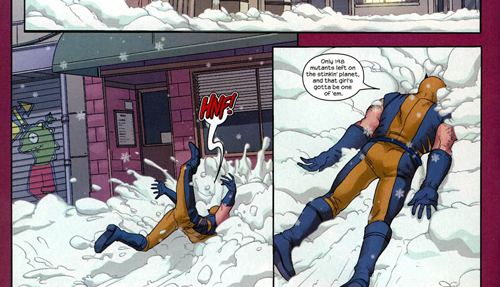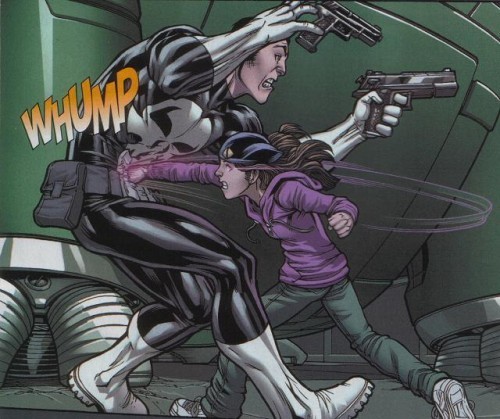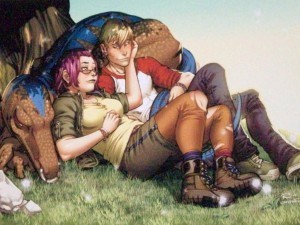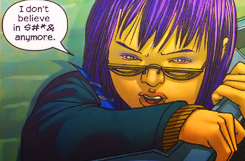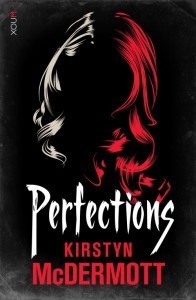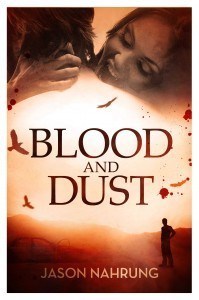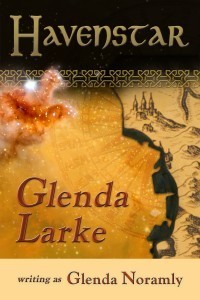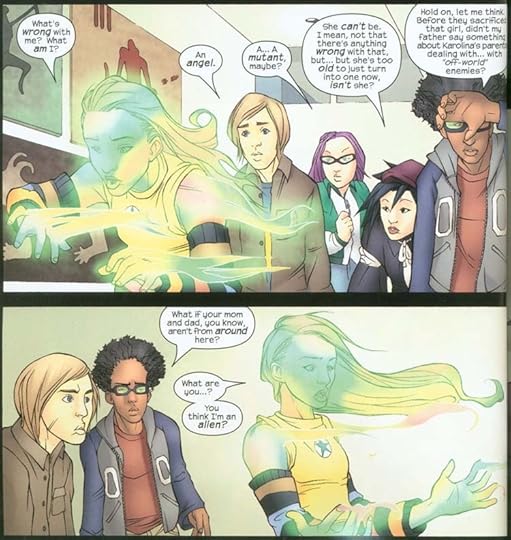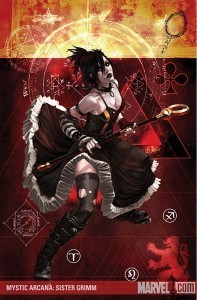Tansy Rayner Roberts's Blog, page 93
December 22, 2012
Tales from the Library: A Room of One’s Own
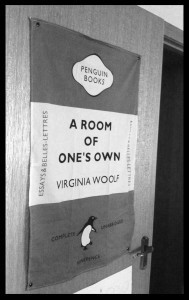 I’ve really been missing my fortnightly upload of current reading into Galactic Suburbia!
I’ve really been missing my fortnightly upload of current reading into Galactic Suburbia!
I used to write reviews a lot, but trailed off from doing it because I found it was getting harder and harder to do, and also limiting my reading because it made it too much like work. Like Kirstyn on The Writer and the Critic, I found that just going BLAHH and talking out my recent reading worked better for me.
But, sniff, no podcast, no podcast until the end of JANUARY cos my fellow podcasters are going away on stupid holidays and honeymoons, whatever. Time for me to figure out a compromise between Reviewing book and just talking about them.
My library – like the physical room where my books live – has been going through some traumas lately, because of a few wild cleaning/re-organising sprees I have inflicted on the rest of the house (and on one memorable occasion, the library’s own walk in wardrobe). I try to keep it clean and tidy and inviting for guests as well as myself, but its large floor space does rather mean that when we have to put boxes SOMEWHERE, or um somebody accidentally bought three more flatpacks of furniture than our house actually needs, well. The library is usually the sacrifice.
It was certainly sacrificial space last weekend when I tore into the walk in wardrobe, transforming it from a Pit of Despair to a Quite Orderly Space.
Add to this the fact that the library en-suite is currently the Zone of Toilet Training and, well, yes.
Did I mention my library has an en-suite? It is the room that should logically be the Master Bedroom, and in fact was our bedroom for a good part of our time here. We moved into it when Raeli was a baby, and didn’t manage to give her a room of her own for two and a half years because the only rooms available were at the very far end of our long, long house. Eventually we moved up the other end into a much smaller room when she got her own room, and all was fine.
When Jem came along, we hauled ourselves back to the abandoned Big Front Bedroom and settled her into the bassinet there, although the convenience of having a parental bedroom at the front AND back of the house became rather too convenient when it came to a certain male parent slipping away to get more sleep than a certain female parent by ‘keeping Raeli company’ at the end of the house that didn’t have a crying baby in it.
Also, Raeli was still only 4 and did genuinely feel a bit abandoned at her end of the house.
So our new compromise was to ditch my old study to be Jem’s bedroom at what felt like a super early age to have her own space (six months), the benefit being that it was right next door to our room and Raeli’s. All sleeping together at one end of the house. But the weird part was that the only room available for my study was the massive master bedroom at the front, complete with en suite bathroom and walk in wardrobe. I mean, I wasn’t complaining or anything, but it did feel decadent…
Thanks to narrow corridors etc. it also meant getting rid of our bed, which was fancy and wooden and beloved. I was a bit sad about that, as well as regretful that we would be losing our convenient spare queen sized bed for guests. Until my honey had a brainwave – why lose the bed? Why CAN’T you have a bed in a study? Or indeed, a library.
I could have squeezed a desk in there, but I didn’t. I do all my writing in armchairs or at the dining room table, anyway. It wasn’t a study in the way my previous room had been – it was definitely a room of Bookshelves and Bed, and what else does a library need? We ordered me a wingbacked chair for my birthday/mother’s day a couple of years ago, and never looked back.
When the library is clean and tidy, it’s a happy space. I can retreat in there to read, though lying on the bed with a book is practically a gilded invitation for the girls to come and leap on me. I’m okay with that. Sometimes they even bring books with them in pretence that they’re not just in it for horsie rides.
(Horsie rides is when one of them sits on my back and pretends I’m a horse, while I read a book. It’s one of the last vestiges of Raeli’s younger years when I managed to devise all KINDS of games that involved me reading a book while she did the ‘fun’ part)
The girls know that the library is special. They are not allowed in there on their own (after the horrible cushion plucking incident of 2011) though Raeli sometimes is, with permission. There is no eating in the library (though my adult friends are occasionally allowed to smuggle a cup of tea in there).
Right now, Raeli and I are reading our way through the Marcia Williams kids graphic novel of the Iliad and the Odyssey at bedtime, two pages a night, and as her sister now goes to bed with the door open, we have to sneak down to the library to do it – lying on the bed, I read the text while she reads the speech bubbles. I’m enjoying it like crazy, not least because this book, which I snuck into her Christmas pile a year ago, is one she has now seized upon all by herself and wants to share with me, because she freaked herself out with the bit where Hector is horribly killed, and you kind of need a Mummy there when dealing with Odysseus and the Cyclops.
I love my library. I feel physically better when the bed is clear of laundry and ready to be read upon. If I have a new year’s resolution (and I never do, except where reading is concerned), it should probably be to keep that space clean, clear and inviting as much as possible in the coming year.
Also, I should build that flat pack furniture.
Where the Wonder Women Are: #34 Molly Hayes/Bruiser of the Runaways
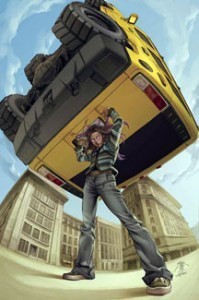 Okay, I have another favourite. Don’t tell Gert! But how can you not love an eleven-year-old who goes by the superhero name Bruiser?
Okay, I have another favourite. Don’t tell Gert! But how can you not love an eleven-year-old who goes by the superhero name Bruiser?
Well, she was Princess Powerful first, but even that is pretty awesome.
Molly is the one element of the Runaways series which makes it a far more morally crunchy story, and helps to take some of the potentially romantic gloss off the running away plot. When the teens discover that their parents are evil – and not just a bit evil, but probably going to sacrifice all of us in their bid to rule the world evil – their first moral quandary is what to do about Molly. She’s one of them, she has to be, but they are all in their mid to late teens, and while running away isn’t a choice they take lightly, it feels like the responsible thing to do.
Choosing to take the eleven-year-old from her parents raises all of the stakes, and a great deal of tension in the story comes from the part that this ragtag bunch of teenagers have dragged the far more innocent Molly along with them. It doesn’t help that Molly doesn’t believe in the evil of their parents, isn’t entirely sure why they are on the run anyway, and pretty much thinks everything is a big fun game.
Protecting Molly’s feelings and her sensibilities became a key priority to all of the other Runaways, and they often tried to shield her from the darker side of what was going on. This meant of course that she was often blithely oblivious to some of the harsher realities in the story – but also forced the others to keep their hopes up and their game faces on. Pretending it was okay for her was often the only thing that kept the whole team going, and united.
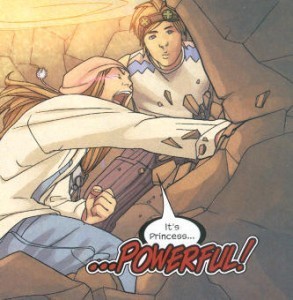 But Molly isn’t as vulnerable as she looks. Each of them have strange powers or abilities to be unveiled, and Molly’s is far more grounded in Marvel Universe traditions than the rest of them – she is a mutant.
But Molly isn’t as vulnerable as she looks. Each of them have strange powers or abilities to be unveiled, and Molly’s is far more grounded in Marvel Universe traditions than the rest of them – she is a mutant.
More to the point, she is a super strong mutant. While this has a lot of fun ‘metaphor for growing up’ material to it, Molly’s experience as a Runaway is mostly a positive one at first. She buys into the idea of them being superheroes pretty easily, choosing the name Princess Powerful for herself, and is often the comic relief rather than an angst-ridden character (though she has her moments).
Molly not only has a ‘kid sister’ relationship with each of the Runaways, especially Chase and Gert, she also later develops a similar friendship with Wolverine, who does rather have a tendency to adopt feisty young teen girls and show them how worthwhile they are. (Also one time, she took Wolverine out with a single punch. Yeah, girl!)
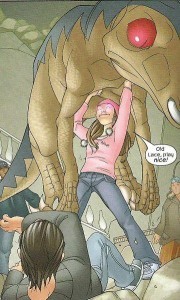 Her super strength started out in fits and brief bursts of energy – while her strength itself seemed limitless (she could fight monsters bigger than skyscrapers, tunnel through miles of rock, have heavy objects broken over her head, etc.) she would often reach her limits afterwards by crashing into deep sleep in order to recover. This lessened as she grew more experienced at using her strength.
Her super strength started out in fits and brief bursts of energy – while her strength itself seemed limitless (she could fight monsters bigger than skyscrapers, tunnel through miles of rock, have heavy objects broken over her head, etc.) she would often reach her limits afterwards by crashing into deep sleep in order to recover. This lessened as she grew more experienced at using her strength.
Her fatigue issues could be a problem if she was still in mid-fight – Nico once gave her a magical caffeine rush to keep Molly awake as she battled a particularly hardy monster.
Molly’s eyes glow pink when she uses her powers, as do those of her parents. It’s a really creepy effect.
More than any of the characters, Runaways explores the theme of ‘growing up’ through Molly. She doesn’t have a mother around to talk ‘girl stuff’ with – like her period – and so Gert, Karolina and Nico have to take that role for her. Also sometimes, Chase. In later volumes (the ones I haven’t read!) Molly takes on more responsibility as a team member. When the potentially unreliable cyborg Victor joins their team, Nico puts Molly in charge of ‘babysitting’ him because she is the only one with the strength to take him down if he goes rogue – and as with Chase, Molly develops a big brother-little sister friendship with Victor.
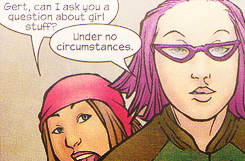 Gert was absolutely Molly’s role model, in smartassery as well as general humanity, and she struggled with her loss after Gert’s death, often continuing to talk to her in her absence.
Gert was absolutely Molly’s role model, in smartassery as well as general humanity, and she struggled with her loss after Gert’s death, often continuing to talk to her in her absence.
Molly’s generally bright view on life, and her innocence as to the seriousness of the world, was used against her by a villain who revealed the true evil of her parents and their deeds. His plan was to kill her as part of his revenge against the Hayes. While Molly and Wolverine did beat him, she was deeply shaken by his revelations as she had lost the last of her illusions about her parents.
Wolverine assured her that no matter what else they had done, her parents must have loved her for her to turn out such a good kid.
Everybody, awww.
Thanks to her mutant identity, Molly seems to have been folded more neatly into the Marvel Universe, and often turns up in cameo appearances in other titles. She was one of the 200 mutants who retained their powers after the House of M storyline that depowered so many. In 2009, a poll about the most powerful female characters in the Marvel Universe ranked her fourth, after Rogue, She-Hulk and Ms Marvel.
Now I want to see her in a She-Hulk title as Jennifer Walters’ intern. What a team up that would be!
Where the Wonder Women Are:
0: Introduction
1: Black Canary
2: Rogue
3: Hawkgirl/Hawkwoman
4: Black Widow
5: Wonder Girl
6: Captain Marvel
7: Vixen
8: Abigail Brand
9. Jubilee
10. Batwoman
11. Catwoman
12. Huntress
13. Robin
14. Batgirl
15. Jean Grey
16. Ice
17. Emma Frost
18. Fire
19. Lady Sif
20. Supergirl
21. The Wasp
22. Gypsy
23. Misty Knight (and Colleen Wing)
24. Mystek
25. Kitty Pryde
26. Crimson Fox
27. The Invisible Woman
28. Dr Light
29. Hawkeye
30. Maya
31. Nico Minoru
32. Karolina Dean
33. Gert Yorkes/Arsenic & Old Lace
December 20, 2012
Friday Links is a Ladyblogger
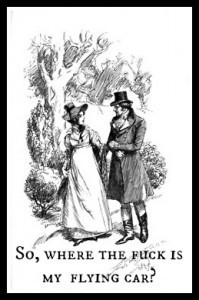 Julia Gillard has been hosting drinks and networking gatherings for all manner of groups this month, because it’s CHRISTMAS, but when she invited a group of women involved in digital publishing (not all bloggers, not all mothers), the media phrased it as her sucking up to “Mommybloggers” – as if that was somehow something cheap and degrading. Anne Summers critiqued this attitude very sharply at SMH, pointing out exactly why Prime Minister Gillard is savvy to get these women on her side.
Julia Gillard has been hosting drinks and networking gatherings for all manner of groups this month, because it’s CHRISTMAS, but when she invited a group of women involved in digital publishing (not all bloggers, not all mothers), the media phrased it as her sucking up to “Mommybloggers” – as if that was somehow something cheap and degrading. Anne Summers critiqued this attitude very sharply at SMH, pointing out exactly why Prime Minister Gillard is savvy to get these women on her side.
I particularly found it interesting when Summers talks about the effect of Gillard’s ‘misogyny speech’ on the women of Australia, and how she has slowly come to realise the changing perception of her because of that one YouTube video – and appears to be growing more confident in her freedom to address women’s issues more candidly.
Ambling Along the Aqueduct is doing their regular series of posts by a variety of ‘regulars’ talking about their year in reading, watching or listening. Mine is here, and I keep thinking of things I forgot to include! But I’m quite pleased with it. Do check out the blog as a whole for the end of year posts, they’re up to 21 already and it’s a lovely and diverse range of people talking about far more than just 2012 releases.
Fablecroft and Twelfth Planet Press are running a promotion where you can get the regency science fiction anthology New Ceres Nights for just $10 (within Australia) when you purchase any other book from either of their stores. To promote this, Tehani has been posting excerpts from each of the New Ceres Nights stories which are bringing back all kinds of memories for me! She’s also including the lovely internal illustrations drawn by Dion Hamill for each of the stories. Here is the excerpt from my piece, “Prosperine When It Sizzles.”
Stumbling Past sums up her year of using the Australian Women Writers Challenge as a reader of history.
Jason Nahrung and Kirstyn McDermott talk about their respective new novel releases from Xoum – Blood and Dust, and Perfections. Rowena also interviews Kirstyn about Perfections.
Laci Green, a sex educator and YouTube vlogger, has written a heartfelt post on Tumblr about how easily that format can be used for online bullying, the specific kinds of online bullying she has been a victim of, and the dismaying trend of bringing the internet down on the head of people for a single mistake (or perception of a mistake). It’s really worth reading her post in full, as one of the clearest explanations I’ve ever seen of why people shift so easily from genuine personal outrage or offence to a quite vicious form of online attack – and why they feel justified in doing so. One of those to bookmark for the next flamewar.
Sarah Rees Brennan has returned to her ‘movie parody’ roots with a hilarious response to The Hobbit: Thorin Dreamboatshield: An Unexpected Hotness of Dwarves. It’s not intended to be spoiler-free, so keep that in mind, but I don’t feel especially spoiled by having read it.
Tobias Buckell has written a long and detailed essay about his experience running a Kickstarter to publish the new novel in his series, and how it worked for him. It’s very compelling as well as educational!
Geekquality has a great essay about the problematic fan responses to Sansa Stark from Game of Thrones.
Kate Elliott confesses to reading reviews of her own work, and talks about what she gets out of it, and how she handles the etiquette of interacting with reviewers.
Sarah Brabazon passed this one on to me: The Business Rusch on ‘Writing Like it’s 2009′ – how the self publishing and digital landscape has changed radically in just the last three years, and what ‘truths’ about publishing then are simply no longer true.
December 19, 2012
Where the Wonder Women Are: #33 Gertrude Yorkes of the Runaways
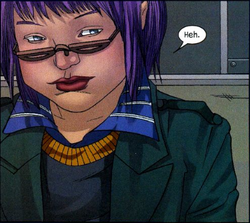 When I first read my way through Runaways, I enjoyed all the characters from whip-smart Alex and doofy but sweet Chase to the troubled, angsty Nico and the even more troubled, even more angsty Karolina. I loved the feisty little girl that was Molly Hayes, too.
When I first read my way through Runaways, I enjoyed all the characters from whip-smart Alex and doofy but sweet Chase to the troubled, angsty Nico and the even more troubled, even more angsty Karolina. I loved the feisty little girl that was Molly Hayes, too.
But Gert got me where I live.
You don’t see fat girls in comics very often. You don’t even see average-sized girls, most of the time. The occasional not-stick-thin figure and She-Hulk’s wider than average shoulders are usually the best you can hope for.
But Gert is chubby. She’s round. And she’s pissed off. Her hair is dyed purple, she wears glasses, she’s both Jewish and agnostic, she’s a socialist, she’s snarky as hell and she has HER OWN DINOSAUR. When they are choosing names for themselves so as to distance themselves from their parents, she chooses Arsenic, purely so she can call her dinosaur Old Lace.
[many many spoilers follow]
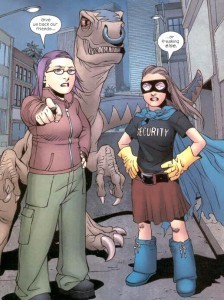 When she and the other kids witness their parents murdering a girl, Gert is the only one not surprised, as she has suspected her own parents of being evil since her pet pig disappeared. She’s also the last one to discard the fake name, finally taking back her own name for herself and recognising that not everything they got from their parents is bad. The telepathic dinosaur, for example.
When she and the other kids witness their parents murdering a girl, Gert is the only one not surprised, as she has suspected her own parents of being evil since her pet pig disappeared. She’s also the last one to discard the fake name, finally taking back her own name for herself and recognising that not everything they got from their parents is bad. The telepathic dinosaur, for example.
I really wish I’d had Gert to read when I was a teenager. She’s great. She has exactly the right attitude for saving the world – that is, she doesn’t want to. She’s grumpy most of the time. She has a strong sense of friendship and honour.
But mostly she’s a cranky fat girl with a kicking indie wardrobe, her own dinosaur and by the way? She gets the guy. The cute guy.
GERT: Chase, are… are you okay?
CHASE: Uh, uh… think I got… brain damage.
GERT: Seriously?
CHASE: Yeah… cause suddenly… you’re the hottest chick… I’ve ever seen.
[He kisses her]
[It’s still going on a few panels later. No complaints from her]
[Chase looks smug]
GERT [to the others]: I was reventilating him. Anyone who says otherwise gets fed to my %$#@ dinosaur.
Ahh, teen romance.
I miss Gert.
Comics people suck.
Gert made me happy from beginning to end in Volume 1 of Runaways. And she’s the reason that I’ll probably never read Volumes 2 and 3, no matter how good they apparently are. Because they went and killed her off, didn’t they?
It’s not like it would have been any better if they had killed off the teen lesbian, the Japanese American sorceress or the pre-teen girl in the team – but Gert was the character I liked best, and once I had been spoiled for the fact of her death, I knew that I never wanted to read it. Which probably means I have missed plenty of Gert smartarsey awesomeness. The X-Men/Runaways crossover event, for instance:
KITTY PRYDE: Hi, I’m Kitty. Are you the token pacifist of your group?
GERT: Not exactly. Pacifists are like vegans, I’m more of a vegetarian. I enjoy fish and occasional maulings.
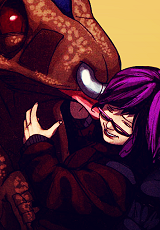 Also the whole sequence where a future Gert calling herself Heroine travels back in time to make some revelations about them all, and dies in Chase’s arms…
Also the whole sequence where a future Gert calling herself Heroine travels back in time to make some revelations about them all, and dies in Chase’s arms…
But yeah, on the whole I am content with my choice to treat Volume 1 as a self-contained story, without going on with it. However, I did discover in my fact-checking for this post that right at the point that Runaways was cancelled or just mysteriously stopped being published halfway through a story arc, it had been teasing readers with the prediction that ‘one would die and one would return to life,’ and the final issue featured Chase being hit by a car after pursuing a girl in the street who looked suspiciously like… guess who?
Ahh, I don’t care. I’m just going to re-read Volume 1 again. Have I mentioned it’s a practically perfect YA novel in graphic art form? Also, there’s this awesomely cynical fat purple-haired girl in it who gets all the funniest lines.
She’s my favourite.
Where the Wonder Women Are:
0: Introduction
1: Black Canary
2: Rogue
3: Hawkgirl/Hawkwoman
4: Black Widow
5: Wonder Girl
6: Captain Marvel
7: Vixen
8: Abigail Brand
9. Jubilee
10. Batwoman
11. Catwoman
12. Huntress
13. Robin
14. Batgirl
15. Jean Grey
16. Ice
17. Emma Frost
18. Fire
19. Lady Sif
20. Supergirl
21. The Wasp
22. Gypsy
23. Misty Knight (and Colleen Wing)
24. Mystek
25. Kitty Pryde
26. Crimson Fox
27. The Invisible Woman
28. Dr Light
29. Hawkeye
30. Maya
31. Nico Minoru
32. Karolina Dean
December 18, 2012
E-books for Christmas
 Surely one of the benefits that the paper book has over its more economical & tree-friendly e-edition is the gifting possibilities. There’s nothing like a comforting, rectangular parcel at Christmas, right?
Surely one of the benefits that the paper book has over its more economical & tree-friendly e-edition is the gifting possibilities. There’s nothing like a comforting, rectangular parcel at Christmas, right?
I’ve been giving books as presents my whole life: childhood classics to my much younger cousin and now to my daughters, my godson & his brothers; art books for my mother; medieval history with ladies in to one particular friend; graphic novels to another. When in doubt, books.
One of my favourite bookshop-at-Christmas memories is sitting in the Hobart Book City, a shop which sadly closed its doors this year. Exhausted from my shopping (Australian Christmas brings the joys of shopping in 30 degree heat) I sat on a random chair and found myself listening to the conversations around me. I learned that the bookshop was full of people who only go into bookshops at Christmas, and aren’t entirely clear how the process actually works. It was something of an eye-opener…
So yes, paper books. I’m fond of them. The Santa stash in the wardrobe currently contains 1 bag of presents for each daughter, and a third entirely peopled with books and DVDs, but mostly books. I parcel them up in batches because we would be there FOREVER if I wrapped each one individually.
Christmas wouldn’t be Christmas without the new Pratchett in hardcover, and a new release by another favourite author like Janet Evanovich is very convenient when my Dad ninjas me with the dread ‘what do you want for Christmas’ question that always leaves my mind blank.
On the other hand, I have been known to beg ‘no books please’ when people ask (unless they are OK with receiving a very specific title request) because I have been trying to reduce my ‘stress caused by unread volumes’ this year, and random paginated delights that I haven’t already psyched myself up to reading only add to that stress.
E-books, though. With e-books I would certainly feel some of that childhood joy of ‘random book I never thought of reading’ pleasure at receiving a rectangular gift, without the accompanying worry about whether I need another new bookcase. (the answer is always yes) Sadly, the embarrassing loss of our Kindle (seriously, we have NO idea where it is) means that this will probably not be an e-book Christmas for our household. Maybe next year.
So e-books. How do you gift them? You can’t wrap them in a satisfying square of paper, right?
Well, no. But more and more people are choosing to read e-books and you have to admit that this close to Christmas, the idea of a gift you can point and click at on a laptop (and then not have to agonise about whether it will be posted in time) is pretty appealing.
Anne Treasure wrote a post for the Momentum blog about gifting e-books: the Lazy Person’s Guide to Gift-Giving, and I was quite pleased to discover (I’ve been out of the loop) that ebook gifting is pretty advanced now – you can even schedule them to arrive at a particular time. My own e-purchasing experiments this year, with magazine subscriptions, was less than hopeful on those terms so the whole ebook thing sounds streamlined and awesome in comparison.
And there’s a big reason, by the way, that I wanted to discuss gifting e-books this year. No, it’s NOT that it’s the most cost-efficient way to give someone my entire Creature Court trilogy (though, that is a very good point). It’s not even that my friend Cheryl Morgan has a fabulous ebook store, Wizard’s Tower, packed with all manner of deeply interesting and/or previously hard to find SF and Fantasy books.
It’s not even Love and Romanpunk, though come on, who doesn’t want a manticore in their stocking?
No, it’s these:
Perfections, the long-awaited second novel by the awesome Kirstyn McDermott, released THIS MONTH as a digital only book from Xoum.
Blood and Dust, a brand-new Australian vampire novel by the most excellent Jason Nahrung, also released THIS MONTH as a digital only book from Xoum.
Havenstar, the long-out-of-print first standalone fantasy novel by the truly epic Glenda Larke (writing as Glenda Noramly), available now for the first time in many years from Smashwords.
This is only the tip of the iceberg but I did particularly want to promote all three books, none of which I have managed to read myself (did I mention, lost Kindle?).
Now it’s your turn! Recommend an e-book in the comments – preferably one where you’ve read it or know the author’s work well and can endorse it without hesitation. And please add a note about what kind of reader is most likely to be pleased if the book in question invades their e-reader at 6:05 AM on Christmas morning.
Christmas Cute
 Jem has *got* Christmas this year. She knows it’s coming, she’s singing the songs, and she refuses to put up with any guff about how many decorations on the tree are handmade by her big sister, thus is claiming that she is personally responsible for anything with a ribbon on it.
Jem has *got* Christmas this year. She knows it’s coming, she’s singing the songs, and she refuses to put up with any guff about how many decorations on the tree are handmade by her big sister, thus is claiming that she is personally responsible for anything with a ribbon on it.
Did I mention singing songs?
This is her version of a certain Christmas classic:
On the first day of Christmas, my true love gave to me
Eight maids a milking
Seven swans a swimming
FIVE GOLD RINGS
Four calling birds
Three fresh hens
Two turtle dogs
And a partridge in a pear tree!
She will then repeat exactly the same verse over and over until forcibly muffled. It’s always the first day of Christmas, the maids always get top billing, and yes she said turtle DOGS.
I think she’s sung it through exactly the same way at least twenty times since December started. I live in constant mild dread that someone will correct her and she will lose her own special version. It feels sometimes like their childhood is all about the adorable things they stop doing.
In other Christmas goodness, a new Diana Comet story! If you haven’t read the charming and genderqueer collection Diana Comet & Other Improbable Tales, then you are missing out. This one, Diana Comet and the Christmas Quilt, is about a girl who asks Diana to “fix” her brother who likes to wear women’s clothes. It is also a story with WALL TO WALL CANDY.
Another Christmas treat – further reasons to argue about the BBC’s definition of “prequel”. But more importantly, extra Madam Vastra and Jenny. I am SO looking forward to this year’s Doctor Who Christmas special:
December 17, 2012
Scream, Victoria, Scream! [WHO-50—1968]
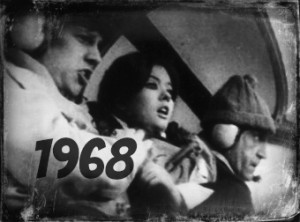 I started out skeptical about the new range of BBC audiobooks based on Target novelisations, especially when they extended to cover later books from stories that still exist. Can’t we just listen to the audio-only version of the missing episodes, or indeed watch the DVD? Which completely ignored my own childhood love of the Target novelisations, and indeed read and re-read many of them instead of pulling down the VHS copy from the shelf.
I started out skeptical about the new range of BBC audiobooks based on Target novelisations, especially when they extended to cover later books from stories that still exist. Can’t we just listen to the audio-only version of the missing episodes, or indeed watch the DVD? Which completely ignored my own childhood love of the Target novelisations, and indeed read and re-read many of them instead of pulling down the VHS copy from the shelf.
Recently I listened to The Dalek Master Plan dual adaption read by Peter Purves and Jean Marsh (having previously experienced the story as an audio soundtrack only) and found it revelatory – not only is it sometimes easier to follow the story of a missing story when there’s proper fictional narrative involved, but if you get a great reader and good production (and indeed the BBC AudioGo talking books are fabulously produced, including music and sound effects) then it can be a wonderful “reading” experience.
For my 1968 post then, while I was dying to (and probably still will) try out my favourite extant Troughton story, The Mind Robber, on my daughters, I decided instead to expand my own Doctor Who experience by listening to the audiobook of Fury of the Deep by Victor Pemberton, read by David Troughton (son of Pat). This story has always been of interest to me because I loved Victoria so much as a kid (based on a couple of other novelisations and how pretty she looked in her photos – we didn’t even have The Tomb of the Cybermen back then, so I’d never seen an episode featuring her). I didn’t manage to get hold of this book in my Target reading days, and hadnot got around to listening to the audio soundtrack of it as I tended to only grab those when I already KNEW I loved the story from reading it in novelisation first.
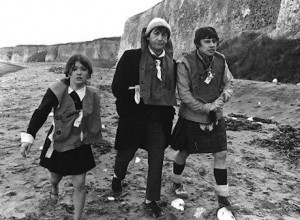 Fury of the Deep is not only a brilliant, complex and quite scary story which draws a line under the ‘base under siege’ trope by doing it so very well, but as it turns out the audiobook was a great way to experience it. David Troughton is an excellent, voice-interesting actor (which is essential in a speaking book!), but also does a subtle and deeply effective impersonation of his father which means that this lost story is full of Troughtony goodness. It’s so hard to feel like you have a handle on the Troughton years with so many stories fragmented or lost, but I retract what I thought before – the audio adaptions of Target novelisations are a great addition to our wealth of Doctor Who merch!
Fury of the Deep is not only a brilliant, complex and quite scary story which draws a line under the ‘base under siege’ trope by doing it so very well, but as it turns out the audiobook was a great way to experience it. David Troughton is an excellent, voice-interesting actor (which is essential in a speaking book!), but also does a subtle and deeply effective impersonation of his father which means that this lost story is full of Troughtony goodness. It’s so hard to feel like you have a handle on the Troughton years with so many stories fragmented or lost, but I retract what I thought before – the audio adaptions of Target novelisations are a great addition to our wealth of Doctor Who merch!
I was mostly listening to this one for Victoria, a character who is often dismissed or criticised by modern fans with little justification. There were no stories extant featuring her for a really long time, and after the flurry of excitement about the discovery of The Tomb of the Cyberman in its entirety in the 90’s, it has quietly slipped away from being a story that many Doctor Who fans are proud to embrace. (though, come on, let’s hear it for the cybermats at least!)
 Victoria is often cited as the epitome of the ‘screamer’ companion, a group which also includes Polly and Mel, but extends at various times (depending on how ungenerous the ear of the critic) to include all of the women from the 1960’s version of the show, plus every female companion except Leela, Romana and Ace. Being ‘a screamer’ has become such a popular meme about the show that nearly every companion from Liz Shaw onwards was described in the media relation to that idea. As was pointed out by I think Toby Hadoke, we lost Elizabeth Sladen, Caroline John and Mary Tamm all in the space of under two years, and all three of them had a statement in their obituary about how their companion had been a ‘new’ take on the companion, more feminist, more of an equal to the Doctor, and so on.
Victoria is often cited as the epitome of the ‘screamer’ companion, a group which also includes Polly and Mel, but extends at various times (depending on how ungenerous the ear of the critic) to include all of the women from the 1960’s version of the show, plus every female companion except Leela, Romana and Ace. Being ‘a screamer’ has become such a popular meme about the show that nearly every companion from Liz Shaw onwards was described in the media relation to that idea. As was pointed out by I think Toby Hadoke, we lost Elizabeth Sladen, Caroline John and Mary Tamm all in the space of under two years, and all three of them had a statement in their obituary about how their companion had been a ‘new’ take on the companion, more feminist, more of an equal to the Doctor, and so on.
You actually can’t divide Doctor Who companions into screamers and non-screamers. Kudos to Louise Jamieson for refusing to let directors or writers keep ‘Leela screams’ in the script, and to Sophie Aldred for blatantly interpreting every ‘Ace screams’ line to be ‘Ace yells in anger and frustration because screw you,’ but when it comes down to it, most of the companions, even the smart and feminist-skewed ones, needed to scream sometimes. A scream is useful. It serves the narrative. It tells the viewers, especially the kids, that this is the point where it’s really scary, and considering how dodgy some of the monster design was at times, you can’t blame the writers for wanting to hang a lampshade on such moments.
The Doctor has never been portrayed as the point of view character, but as the clever adventurer who (mostly) knows more than everyone else. It’s to Doctor Who’s credit that there has almost always been a female companion to represent the point of view of the audience, though in the 1960’s black and white days there was usually a bloke as well. And you know, the Second Doctor and Jamie did their share of screaming (or at least, fearful yelling at slightly less sharp pitches), we just never hear about it.
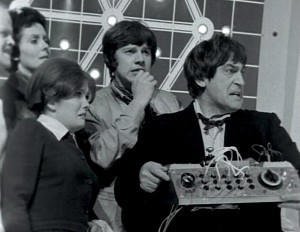 But Victoria screamed, and most fans don’t remember or discuss anything else about her. She was an awesome screamer, actually, and the cabaret performance that has gone on around Troughton era actors at conventions since the 1980’s has constantly reminded us that Deborah Watling was nicknamed ‘Leatherlungs’ on set.
But Victoria screamed, and most fans don’t remember or discuss anything else about her. She was an awesome screamer, actually, and the cabaret performance that has gone on around Troughton era actors at conventions since the 1980’s has constantly reminded us that Deborah Watling was nicknamed ‘Leatherlungs’ on set.
Her screaming prowess was legendary, not topped until Bonnie Langford came along in 1986 and JNT thought to ask her if she could scream in the right key to match the closing credits music sting.
In Fury of the Deep, Victoria’s final story, her scream was the secret to defeating the monster. Which always sounded like a bad joke and in the context of the story is treated quite humorously. However, given that this and the banter between the terrified companions is basically the only humour in six tension-packed episodes, I’m prepared to let it slide. When it comes to the moment itself, it’s not funny at all, as Victoria’s sheer terror takes over.
Companions need to be brave and bold and funny and self-reliant (but not too self-reliant) to function in the context of the show. But they also need to be scared and vulnerable because if they’re not, if they really are too cool for school, then it’s all too easy to lose the audience’s willing suspension of disbelief. This is a story about scary sea foam. SCARY SEA FOAM. And it’s to Deborah Watling’s (and Victoria’s) credit that the premise was pulled off so effectively.
Heh so that’s my rant about how people should stop ragging on the ‘screamer’ companions and let them get on with their job. Let’s talk about the actual plot:
 The Doctor, Jamie and Victoria land on a grey English beach, have a mock snow fight in the unusually thick sea foam, get shot as trespassers and taken on to a large oil refinery, where they discover an atmosphere of tension thanks to to the loss of contact with various oil rigs out to sea. There’s something nasty in the water, and it gets nastier and nastier, controlling the minds of humans who get in its way and turning them into mindless zombies. The refinery crew include Robson, the too-proud-for-his-own-good boss, his sweet and ineffectual deputy Harris, and Van Lutyens, a pragmatic advisor from the Dutch government. The other main cast member is Maggie, Harris’ wife who lives in the married quarters on the base (domesticity!), and is taken quite early by the Something Nasty. Oh and some lovely creepy “villains”/seaweed zombies, Mr Oak and Mr Quill, who felt like they belonged in either a Pratchett novel or a Tarantino film.
The Doctor, Jamie and Victoria land on a grey English beach, have a mock snow fight in the unusually thick sea foam, get shot as trespassers and taken on to a large oil refinery, where they discover an atmosphere of tension thanks to to the loss of contact with various oil rigs out to sea. There’s something nasty in the water, and it gets nastier and nastier, controlling the minds of humans who get in its way and turning them into mindless zombies. The refinery crew include Robson, the too-proud-for-his-own-good boss, his sweet and ineffectual deputy Harris, and Van Lutyens, a pragmatic advisor from the Dutch government. The other main cast member is Maggie, Harris’ wife who lives in the married quarters on the base (domesticity!), and is taken quite early by the Something Nasty. Oh and some lovely creepy “villains”/seaweed zombies, Mr Oak and Mr Quill, who felt like they belonged in either a Pratchett novel or a Tarantino film.
Gas, foam and seaweed. Yes, all these things can be scary if done right.
One of the main reasons I was interested in this story is that I’d always felt vaguely unsatisfied about the explanations as to Victoria’s leaving story in the Doctor Who Programme Guide: stays with the Harris family. Really? What’s so special about the Harris family? Sure, her Dad got killed by the Daleks back in her own 19th century, but isn’t it weird that a 16 year old girl not only chooses to give up space travelling, but deliberately selects a different century to the one she was born in? Susan and Vicki did it, but love was given as the motivation there, and then there’s Steven but I’ve never quite understood why he left either, having never listened to, read or watched The Savages.
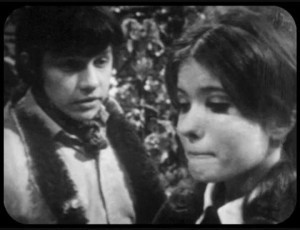 I shipped Jamie and Victoria from the time I was about seven years old. In the stories and particularly the novelisations of this era, it’s very clear that Jamie is soppy for Victoria and they are terribly special to each other. Looking at them now, I think the writers & actors were in fact coding them as ‘romantic’ in the same way that Barbara & Ian and Ben & Polly were – that is, never openly acknowledged, but blatantly obvious.
I shipped Jamie and Victoria from the time I was about seven years old. In the stories and particularly the novelisations of this era, it’s very clear that Jamie is soppy for Victoria and they are terribly special to each other. Looking at them now, I think the writers & actors were in fact coding them as ‘romantic’ in the same way that Barbara & Ian and Ben & Polly were – that is, never openly acknowledged, but blatantly obvious.
Both the Barbara-Ian and Polly-Ben relationships are treated as akin to canon now by fandom (and have both been acknowledged in official spin off productions), but Jamie and Victoria are not, because of course they didn’t leave together. (Funnily enough I never got that sense about Jamie and Zoe at all – maybe because I read fewer of their adventures through the novelisations? Or maybe it just wasn’t there? Ditto for Steven & Vicki who feel entirely siblingy)
In Fury of the Deep, it is especially obvious that Victoria leaving the Doctor is sad, but the bit that is making her so agonised about it is saying goodbye to Jamie. That’s such a rare thing in this show! We talk very often about the many unsatisfying or rushed farewell episodes in Classic Who, but it is very rare that a companion has a closer relationship with their fellow companion than with the Doctor himself – and still leaves separately. I think the Tegan/Nyssa friendship is probably the only example, with maybe a little Harry/Sarah (though of course they both returned to the same era individually and could easily have met up for cups of tea and reminiscences at any time).
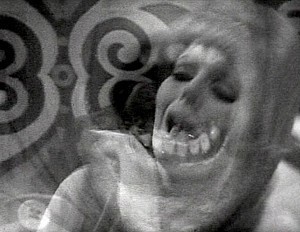 I was deeply surprised to discover that the Harrises were not in fact an older couple with whom Victoria found an adoptive family to replace her father. The novelisation makes it very clear that they are quite young, both in their 20’s. More to the point, neither of them develop much of a relationship with Victoria throughout the story – neither of them have anything like a proper conversation with her until the last episode and even that is pretty random.
I was deeply surprised to discover that the Harrises were not in fact an older couple with whom Victoria found an adoptive family to replace her father. The novelisation makes it very clear that they are quite young, both in their 20’s. More to the point, neither of them develop much of a relationship with Victoria throughout the story – neither of them have anything like a proper conversation with her until the last episode and even that is pretty random.
In fact, Victoria doesn’t choose to stay “with the Harrises” at all – that is a last minute suggestion by the Doctor to make himself feel less irresponsible about abandoning his latest 16-year-old orphan in the 1960’s. Instead, Victoria’s choice to leave the TARDIS. And while the Harris solution (they are asked to keep an eye on her and help her get settled, not to adopt her) seems to be last-minute, Victoria’s leaving story is actually a major theme of the whole story.
Like Tegan fifteen years later, Victoria leaves because it’s not fun any more. I don’t know how much of the seeding of her discontent through the whole story is a novelisation thing (who has listened to the original audio track and can shed light on this?), but it certainly feels that her choice in the last episode is inevitable. She is struggling with being scared all the time and on the run, and at the same time regularly checking in with Jamie who thrives on the adventure.
I was concerned at first that they were actually trying to sell Victoria as a failed companion, one who couldn’t cut it (which would explain so much fan antipathy towards her) but by the end of the story I wasn’t getting that sense at all. Victoria has loved some her time in the TARDIS, but ultimately the negatives are outweighing the positives, and this particular “adventure” is just so scary and so tiring that she is done.
It’s also worth pointing out that Victoria never chose to come with them in the first place, but was whisked away by the Doctor and Jamie who didn’t want to leave her ‘alone’ after the death of her father.
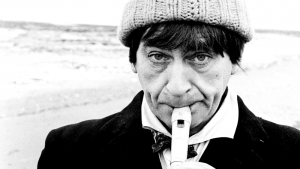 I thought that the comparison between Jamie (very much of the ‘I will be with you forever, Doctor’ vein) and Victoria was done rather sensitively – she can see how much her friend delights in the Doctor’s madcap lifestyle and never questions it, and can also see that she does not have anything like that level of appreciation for it. At the same time, Jamie is wounded and hurt by Victoria’s loss of faith, taking it personally, which really resonated with me. You know how you can be so completely immersed in a hobby or a community or a project and someone you share it with moves on or falls out of love with it before you do? It’s exactly that!
I thought that the comparison between Jamie (very much of the ‘I will be with you forever, Doctor’ vein) and Victoria was done rather sensitively – she can see how much her friend delights in the Doctor’s madcap lifestyle and never questions it, and can also see that she does not have anything like that level of appreciation for it. At the same time, Jamie is wounded and hurt by Victoria’s loss of faith, taking it personally, which really resonated with me. You know how you can be so completely immersed in a hobby or a community or a project and someone you share it with moves on or falls out of love with it before you do? It’s exactly that!
I’ve read reviews that suggest the Doctor takes the choice away from Victoria (as he did with Susan) by vocalising her desire to leave and setting it up for her, but I don’t think that’s what happens at all. Victoria has been expressing her choice through the whole story, but is choked up and guilty about saying it out loud, and he makes it easy on her. I also appreciated the fact that the Doctor and Jamie gave her an extra night to think about it instead of whisking her away immediately – Tegan could have done with that level of thoughtfulness, twice over!
All in all this was a very pleasing experiment. But I am now even more sold on the idea that there is a sneaky unseen season 6B in which older versions of the Doctor, Jamie and Victoria run around the universe doing jobs for the Time Lords. Imagine what an older, smarter Victoria who has been exposed to all of British society’s changes in the late 60’s could do with a TARDIS, a mission, and her boys.
ELSEWHERE ON 1968:
The Web of Fear [Wife in Space]
Fury from the Deep [Wife in Space]
Fury From the Deep [Fourth Dimension]
Wheel in Space Episode 6 [Chronic Hysteresis]
Zoe [Marlow Inc]
The Dominators [Kasterborous]
The Mind Robber Episode 1 [Chronic Hysteresis]
The Brigadier [Marlow Inc]
The Invasion [Wife in Space]
December 16, 2012
Where the Wonder Women Are #32: Karolina Dean of the Runaways
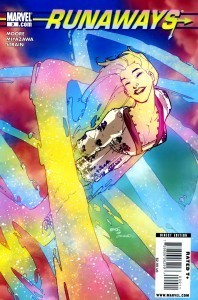 So you think your teen years were tough. Karolina is an alien AND a lesbian. When she and her fellow Runaways discover that their parents are all evil, she has rather more to take in than the rest of them because of the sudden revelation that instead of being the daughter of two famous Hollywood celebrities, she is in far the daughter of two solar-powered alien invaders.
So you think your teen years were tough. Karolina is an alien AND a lesbian. When she and her fellow Runaways discover that their parents are all evil, she has rather more to take in than the rest of them because of the sudden revelation that instead of being the daughter of two famous Hollywood celebrities, she is in far the daughter of two solar-powered alien invaders.
On the bright side, she can fly and shoot rainbows out of her skin. So there’s that!
When we first meet Karolina, she appears to be every bit the stereotype of a Californian blonde – remember Dawn from the Babysitters Club? Karolina is a bit of a hippy, a vegan, a flawless beauty, and the sort of person who generally believes the best of people.
This is a bit of a problem because unlike the other kids, she misses the moment when their parents sacrifice an innocent girl, and then struggles to take their word for it. Later, when the Runaways decide to ransack their various family homes to collect evidence as to the wrongdoings of their parents, Karolina finds a message she is supposed to read in the event of her parents’ deaths: she is to remove the medical alert bracelet she has worn her whole life.
Freed of what turns out to be an alien artefact, she starts to glow with her alien, sun-induced powers, and life is never the same again. She has many struggles to cope with her powers which are not exactly subtle, and overwhelm her body. Oh, what’s that, another supernatural metaphor for being a teenager? Your body is changing against your will, you say?
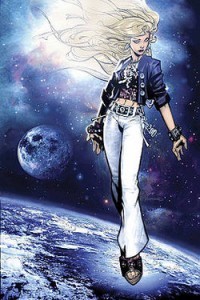 When they choose their hero names, Karolina wants to be ‘Lucy in the Sky’.
When they choose their hero names, Karolina wants to be ‘Lucy in the Sky’.
On the surface a beautiful, sweet and popular girl (who comes from a background of immense privilege), Karolina struggles with her identity as a ‘freak’ – and it becomes clear that while this is at least partly about the shock of discovering she is not human, it’s not just about that. The revelation about her sexuality is a very slow and subtle one over the original 18 issues – I spotted it early and enjoyed watching that aspect of the story unfold, and thought that it was handled very sensitively as a piece of background characterisation.
In later volumes, after the original parental plot is resolved, Karolina declares her feelings for her close friend Nico, who had recently sworn off boys but still turns her down on account of being straight. Karolina later meets the fiancé originally arranged by her parents, Xavin of the Skrull race, and returns to her home planet with him/her – a trip which allows her to better come to terms with her alien heritage as well as training with her powers.
 Xavin is a shape changer and originally appeared in male shape but regularly takes on a female form in order to be more appealing to Karolina. She occasionally switches back to male appearance when a male body is more convenient (intimidation purposes, etc., which Karolina thinks is sexist) The gender switching makes it hard for the group to accept Xavin as a trusted member. Her tendencies towards extreme violence are also not overly helpful in this regard and Nico in particular is very suspicious of her even after she has joined the team.
Xavin is a shape changer and originally appeared in male shape but regularly takes on a female form in order to be more appealing to Karolina. She occasionally switches back to male appearance when a male body is more convenient (intimidation purposes, etc., which Karolina thinks is sexist) The gender switching makes it hard for the group to accept Xavin as a trusted member. Her tendencies towards extreme violence are also not overly helpful in this regard and Nico in particular is very suspicious of her even after she has joined the team.
Karolina’s own hesitations and suspicions about Xav’s changeable nature are put at rest when she discovers that when under pressure or stress, the form that Xavin is more likely to retreat to is the female.
Since her trip to her home planet (which ended in war breaking out just before she and Xav were supposed to get married), Karolina has learned to control her powers far more effectively, and can now choose whether or not she glows or hovers in the air – she can also control mighty solar blasts, fine laser beams, and forcefields. Like a solar battery, though, once she runs out of juice, she needs to recharge.
Did I mention she sparkles like a rainbow?
Where the Wonder Women Are:
0: Introduction
1: Black Canary
2: Rogue
3: Hawkgirl/Hawkwoman
4: Black Widow
5: Wonder Girl
6: Captain Marvel
7: Vixen
8: Abigail Brand
9. Jubilee
10. Batwoman
11. Catwoman
12. Huntress
13. Robin
14. Batgirl
15. Jean Grey
16. Ice
17. Emma Frost
18. Fire
19. Lady Sif
20. Supergirl
21. The Wasp
22. Gypsy
23. Misty Knight (and Colleen Wing)
24. Mystek
25. Kitty Pryde
26. Crimson Fox
27. The Invisible Woman
28. Dr Light
29. Hawkeye
30. Maya
31. Nico Minoru
December 15, 2012
Where the Wonder Women Are #31 Nico Minoru & the Runaways
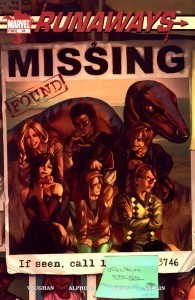 Consider this Runaways Week in the Where the Wonder Women Are Universe!
Consider this Runaways Week in the Where the Wonder Women Are Universe!
Just when I thought I understood comics, and the Marvel Universe in particular, Runaways came along to shake up my perceptions. The original self-contained Volume of 18 issues (2003-2004), created by Brian K Vaughan and Adrian Alphona, is an edgy teen paranormal story about six kids who have to entertain each other once a year when their parents gather for a secret meeting… and finally discover the horrible truth that their parents are in fact “the Pride,” a group of criminal magicians, super-villains, aliens and so on.
The kids go on the run, in a story that feels far more like a Scott Westerfeld novel than a comic, except for the fact that they are grounded in the Marvel Universe – characters such as Cloak and Dagger and even Captain America cross their paths from time to time, and ultimately it is superheroes who are responsible for the resolution of the story and the “happy ending” temporarily created for the runaways (which they ultimately reject because superheroes, what do they know about real life?).
But for the most part, despite the universe they belong to, the Runaways of the original series are in their own genre, telling their own story. They’re not out to save the world or fight for justice – they just want to escape the fate that their evil parents have in store for them. And along the way they discover their own innate powers or gifts: one of them is a mage, one a mutant, one an alien, one has a telepathic connection to a dinosaur, one has his father’s futuristic tech-gloves, and so on.
It’s not a happy story, but these misfits form a fractured and dysfunctional family group to replace what they have lost. Right up to the point that they discover that one of their own is every bit as evil as their parents…
Really trying not to spoil the main narrative of the original volume here, but chances are I will.
I’ll admit right here that I haven’t read beyond the original series, largely because I found out the fate of one of my favourite characters, got angry about it, and refused to read further, despite the involvement of Joss Whedon, Sara Pichelli and other comics creators I respect in the various volumes of the series. I have come across later versions of these characters as they are folded into the Marvel universe, and with a Civil War crossover featuring the Young Avengers, but I have gaps. I may always have gaps.
Where Runaways is special is that it is thoroughly modern in its attitude to teenagers and young adult storytelling – far more realistic than the usual combination of teenage characters and super heroics. The characters are diverse, interesting and imperfect, and as with Buffy the Vampire Slayer and Peter Parker in Ultimate Spider-Man (the two best examples of this I can think of) the supernatural elements in the story are used as powerful metaphors for all the other crap that teenagers have to deal with.
The boys are cute, don’t get me wrong, but I’m here to talk about women in superhero comics, and Runaways gives us some brilliant examples of this – not to mention, in the original lineup, a gender balance where the girls outnumbered the boys. THIS NEVER HAPPENS IN TEAM BOOKS. Well, except in overtly female team books like Birds of Prey. Runaways isn’t waving a big old feminist flag – it’s just discreetly hanging it in the background.
So who are the women of the Runaways? Let’s start with Nico.
A Japanese-American goth girl who dresses in fancy black lace outfits, Nico is one of the first of the group to realise that while they have fled their parents, they can’t outrun what they are.
She has inherited the magical abilities of her parents, dark wizards, and has a really disturbing power staff which requires her to draw her own blood in order for it to emerge FROM HER CHEST. There’s an obvious connection here to teen self-harm, such a common phenomenon among young women, and it is squirmy to watch her come to terms with her power and the weapon she wields for this reason.
On the other hand, that time she was being fed on by a vampire and her staff burst out, staking him through the chest – that was pretty awesome.
Later on she cuts herself less to bring forth the staff and utilises other means, such as brushing her teeth *really* hard. Also her menstrual cycle is addressed: when she has her period, the staff is always available!
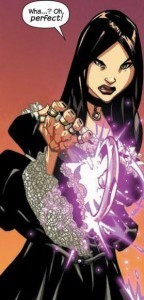 I very much enjoyed the limitations built into Nico’s spellcasting ability – she can do absolutely anything with her staff but can only cast a spell once, which means that as time goes on she has to become more and more creative with how to get the job done. “Freeze” once used is gone forever, and any accidental or deliberate attempt to repeat a spell results in disaster.
I very much enjoyed the limitations built into Nico’s spellcasting ability – she can do absolutely anything with her staff but can only cast a spell once, which means that as time goes on she has to become more and more creative with how to get the job done. “Freeze” once used is gone forever, and any accidental or deliberate attempt to repeat a spell results in disaster.
There’s also an emotional component to her spells – if her staff represents self-harm, then her spell casting verges on depression at times, with her having to call up negative and sad memories in order to make the spells work.
The runaways all choose ‘hero’ names for themselves, but later drop them as holding on to their original identities becomes more important to them. Nico’s chosen name was Sister Grimm.
In later volumes of Runaways, Nico has taken on the role as the leader of the team. Her powers have been developing in strength as well, so that she is capable of far more than when she started.
As part of the current Marvel NOW releases, Nico and her fellow Runaway Chase will join new title Avengers Arena which mixes up a bunch of teen characters from Avengers Academy and other books into a Hunger Games style scenario on the charmingly named Murder Island: kill or be killed.
My money’s on Nico to make it to the end.
Where the Wonder Women Are:
0: Introduction
1: Black Canary
2: Rogue
3: Hawkgirl/Hawkwoman
4: Black Widow
5: Wonder Girl
6: Captain Marvel
7: Vixen
8: Abigail Brand
9. Jubilee
10. Batwoman
11. Catwoman
12. Huntress
13. Robin
14. Batgirl
15. Jean Grey
16. Ice
17. Emma Frost
18. Fire
19. Lady Sif
20. Supergirl
21. The Wasp
22. Gypsy
23. Misty Knight (and Colleen Wing)
24. Mystek
25. Kitty Pryde
26. Crimson Fox
27. The Invisible Woman
28. Dr Light
29. Hawkeye
30. Maya
December 13, 2012
Friday Links is Dressed Like a Reindeer
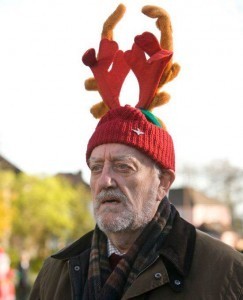 It was school final assembly day today! I can’t tell you how much I am looking forward to three year old Jem being at school in an assembly with me NOT having a toddler younger sibling to juggle madly in order to hear an hour or so of children singing and playing xylophones in Santa hats. I brought three kinds of snacks, people! And it wasn’t ENOUGH.
It was school final assembly day today! I can’t tell you how much I am looking forward to three year old Jem being at school in an assembly with me NOT having a toddler younger sibling to juggle madly in order to hear an hour or so of children singing and playing xylophones in Santa hats. I brought three kinds of snacks, people! And it wasn’t ENOUGH.
But never mind that, on with the links.
One of the last reviews (I presume) on the ASif site is Tehani talking about her thoughts on Chicks Unravel Time. Spoilers, she loved it! I am so looking forward to introducing her to black and white Who now that talk of Jamie and his kilt has lured her in.
Our friend (and fellow Who blogger) David McDonald has written his own piece of pop culture commentary: a great post about Worzel Gummidge over at Cult Britannia, a site I had never known existed but will be spending a lot of time at in the near future. Worzel Gummidge, people! Remember him?
The big news of the week was Gail Simone’s unceremonious (and unwarranted) firing off the successful Batgirl title. Much anger and upset about this online but the basics are covered by this article on the Mary Sue.
Also on the Mary Sue, a discussion of proposed rules to ensure gender parity in the Royal Shakespeare Company.
Bitch Magazine looks at the sexist comments made by Bret Easton Ellis towards Oscar-winning filmmaker Kathryn Bigelow.
Rather more positively, check out the Daily Life list of 20 greatest moments for women – I forsee lots of nominees for the Galactic Suburbia award in this slideshow! it mostly has an Australian angle to it but also includes a few international phenomena, and generally makes you feel that yes, things CAN get better.
This link via my Mum: NITV, a channel of indigenous television, available now free to air. One of those gobsmackingly important things that makes you wonder why this wasn’t done twenty years ago. I’m particularly excited about the kids show lineup. Good on SBS & the government for making this happen (though, seriously, TWENTY YEARS AGO).
Jonathan Strahan provides an easy list of links to the first couple of months of free fiction at Eclipse Online – bookmark, read and enjoy!
Speaking of bookmarking, reading & enjoying, a belated link to the latest Downunder Feminist Carnival. So much linky goodness!
An interesting piece on The Huffington Post takes on the idea that we need to teach young men to read and appreciate books with female heroes in them.

